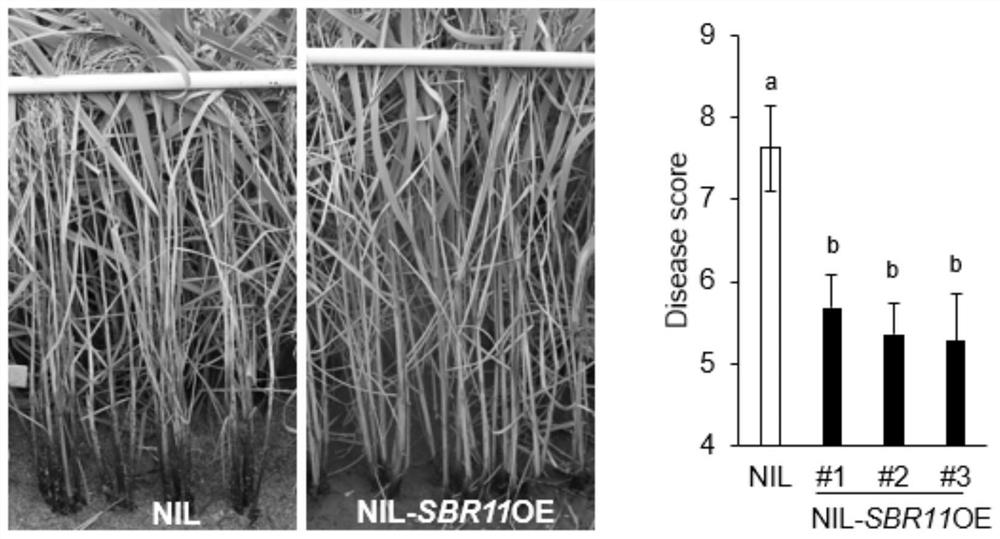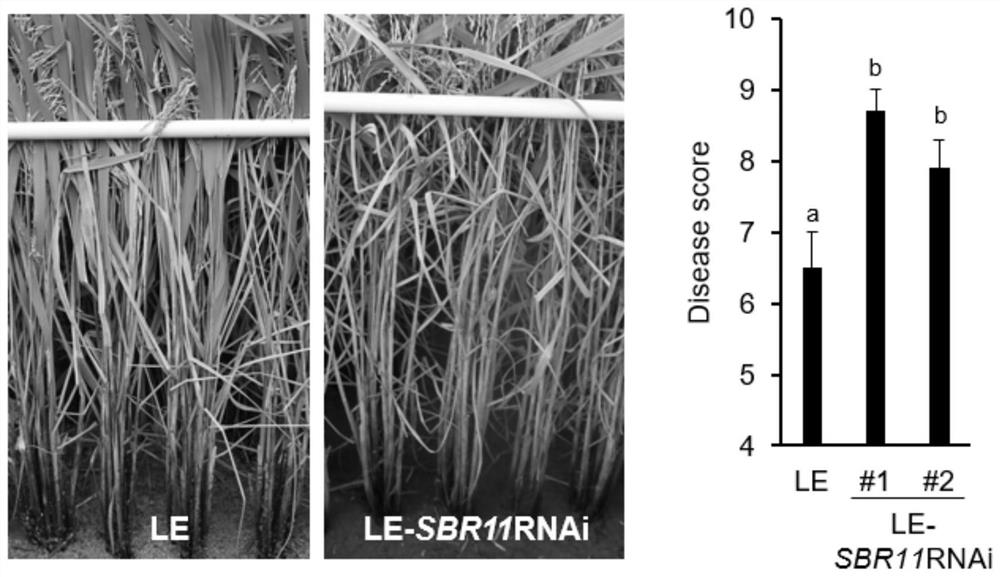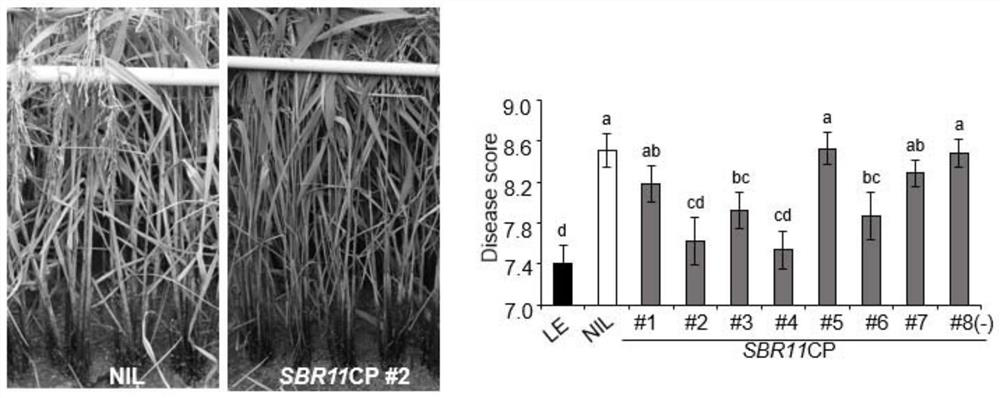Rice sheath blight resistance gene SBR11 as well as molecular marker and application thereof
A technology of molecular markers and sheath blight, which is applied in the fields of application, genetic engineering, and plant genetic improvement, can solve problems such as poor results, and achieve the effect of speeding up the breeding process and improving resistance
- Summary
- Abstract
- Description
- Claims
- Application Information
AI Technical Summary
Problems solved by technology
Method used
Image
Examples
Embodiment 1
[0035] Embodiment 1, verification of candidate genes
[0036] In this practice, a near-isogenic line constructed by LE and TQ was used, and a candidate gene SBR11 for resistance to sheath blight was detected on chromosome 11 of LE. In order to verify the function of the gene, the present invention constructs SBR11 overexpression (SBR11OE) and RNAi vector (SBR11RNAi), and transfers the SBR11-OE vector into the susceptible near-isogenic line NIL-SBR11 TQ (NIL), the SBR11RNAi vector was transferred into LE. The field resistance identification results showed that compared with the control, the resistance of the SBR11OE transgenic line to sheath blight was significantly increased ( figure 1 ), the resistance of SBR11RNAi transgenic lines to sheath blight was significantly reduced ( figure 2 ). The full-length gene of SBR11 was cloned from LE, and transformed into the susceptible near-isogenic line NIL, and a blank control (#8) was set at the same time. The inoculation identifi...
Embodiment 2
[0037] Embodiment 2, SBR11 functional analysis
[0038] The resistant allele of SBR11 (SBR11) came from LE, and the indica variety TQ carried the susceptible allele (sbr11) at this locus. The sequencing results showed ( Figure 4), SBR11 not only had 11 SNP differences in the upstream 2kb of ATG between the resistant and sensitive allele donor parents, but also had 5 mutations in the coding region, of which the 190th, 926th and 1492nd positions were sense mutations. The induced expression level of SBR11 after the infection of sheath blight was significantly higher than that of sbr11( Figure 5 ). In order to verify the gene function of SBR11, the present invention uses the overexpression promoter Ubiquitin to drive the coding regions of the two alleles SBR11 and sbr11 respectively, and transfers them into the susceptible near-isogenic line NIL. Transgenic lines were inoculated in vitro with sheath blight in greenhouse ( Figure 6 ) and field inoculation identification ( ...
Embodiment 3
[0042] Example 3, the development of molecular markers
[0043] The present invention develops dCAPS markers for gene selection for the base variation of SNP190 and SNP926, and the specific information of these two dCAPS markers is as follows:
[0044] SNP190: Located at the 4851244th base of rice chromosome 11, that is, the 190th base of the SBR11 gene, the molecular marker polymorphism is T / A, and the sequence of 176 bp before and after the SNP site is shown in SEQ ID No.3 , the 154th bp base is the SNP site 190; the base of the SBR11 disease-resistant allele at this site is T, which will not be recognized by the restriction endonuclease PvuII, and the expanded fragment size is 176 bp. The base of the susceptible allele sbr11 at this site is A, which will be recognized by the restriction endonuclease PvuII, and the 21bp fragment will be cut off, leaving only a 155bp fragment.
[0045] SNP926: Located at the 4851980th base of rice chromosome 11, that is, the 926th base of th...
PUM
 Login to View More
Login to View More Abstract
Description
Claims
Application Information
 Login to View More
Login to View More - R&D
- Intellectual Property
- Life Sciences
- Materials
- Tech Scout
- Unparalleled Data Quality
- Higher Quality Content
- 60% Fewer Hallucinations
Browse by: Latest US Patents, China's latest patents, Technical Efficacy Thesaurus, Application Domain, Technology Topic, Popular Technical Reports.
© 2025 PatSnap. All rights reserved.Legal|Privacy policy|Modern Slavery Act Transparency Statement|Sitemap|About US| Contact US: help@patsnap.com



